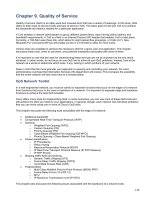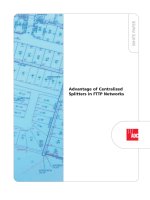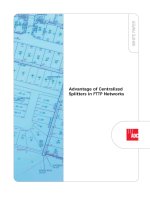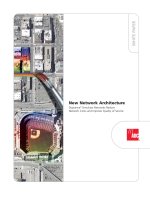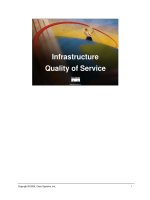Quality of Service in IP Networks
Bạn đang xem bản rút gọn của tài liệu. Xem và tải ngay bản đầy đủ của tài liệu tại đây (180.12 KB, 26 trang )
Queue Management
1
Quality of Service in IP
Networks
CH-1015 Ecublens
Prof. Jean-Yves Le Boudec
Prof. Andrzej Duda
Prof. Patrick Thiran
LCA-ISC-I&C, EPFL
Queue Management
2
Contents
o Principles
o Traffic shaping
l leaky bucket
l token bucket
o Scheduling strategies
l FIFO
l Priority
l Round Robin
l Fair Queueing
l RED
o IntServ
o DiffServ
Queue Management
3
Improving QOS in IP Networks
o IETF groups are working on proposals to provide better QOS
control in IP networks, i.e., going beyond best effort to provide
some assurance for QOS
o Work in Progress includes Differentiated Services, and Integrated
Services (RSVP)
o Simple model
for sharing and
congestion
studies:
Queue Management
4
Principles for QOS Guarantees
o Consider a phone application at 1Mbps and an FTP application sharing
a 1.5 Mbps link.
l bursts of FTP can congest the router and cause audio packets to be dropped.
l want to give priority to audio over FTP
o PRINCIPLE 1: Marking of packets is needed for router to
distinguish between different classes; and new router policy to treat
packets accordingly
Queue Management
5
Principles for QOS Guarantees (more)
o Applications misbehave (audio sends packets at a rate higher than 1Mbps
assumed above);
o PRINCIPLE 2: provide protection (isolation) for one class from other
classes
o Require Policing Mechanisms to ensure sources adhere to bandwidth
requirements; Marking and Policing need to be done at the edges:
Queue Management
6
Principles for QOS Guarantees (more)
o Alternative to Marking and Policing: allocate a set portion of bandwidth
to each application flow; can lead to inefficient use of bandwidth if one
of the flows does not use its allocation
o PRINCIPLE 3: While providing isolation, it is desirable to use
resources as efficiently as possible
Queue Management
7
Principles for QOS Guarantees (more)
o Cannot support traffic beyond link capacity
o PRINCIPLE 4: Need a Call Admission Process; application flow
declares its needs, network may block call if it cannot satisfy the
needs
Queue Management
8
Policing Mechanisms
o Three criteria:
l (Long term) Average Rate (100 packets per sec or 6000 packets per min??), crucial
aspect is the interval length
l Peak Rate: e.g., 6000 p p minute Avg and 1500 p p sec Peak
l (Max.) Burst Size: Max. number of packets sent consecutively, ie over a short
period of time
Queue Management
9
Traffic shaping
o How to prevent congestion?
l it may result from burstiness
l arrivals more deterministic, better performance
– example : nbr of customers in D/D/1 vs. G/D/1
l control the rate and burst size
– traffic description
o Service contract
l if the network knows the type of the traffic, it can reserve resources to support
the traffic
l contract between the source and the network
– source: traffic description
– network: QoS guarantee if the traffic conformsto the description
– if the traffic is not conformant, penalty: reject a packet, no guarantees of the QoS
(traffic policing)
o More details in Network Calculus course
Queue Management
10
Leaky bucket
o Limited size buffer with constant departurerate
l r if buffer not empty
l 0 if buffer empty
o Equivalent to the queue G/D/1/N
o Fixed size packets
l one packet per clock tick
o Variable size packets
l number of bytes per clock tick
o Packet loss if buffer filled
r
B

